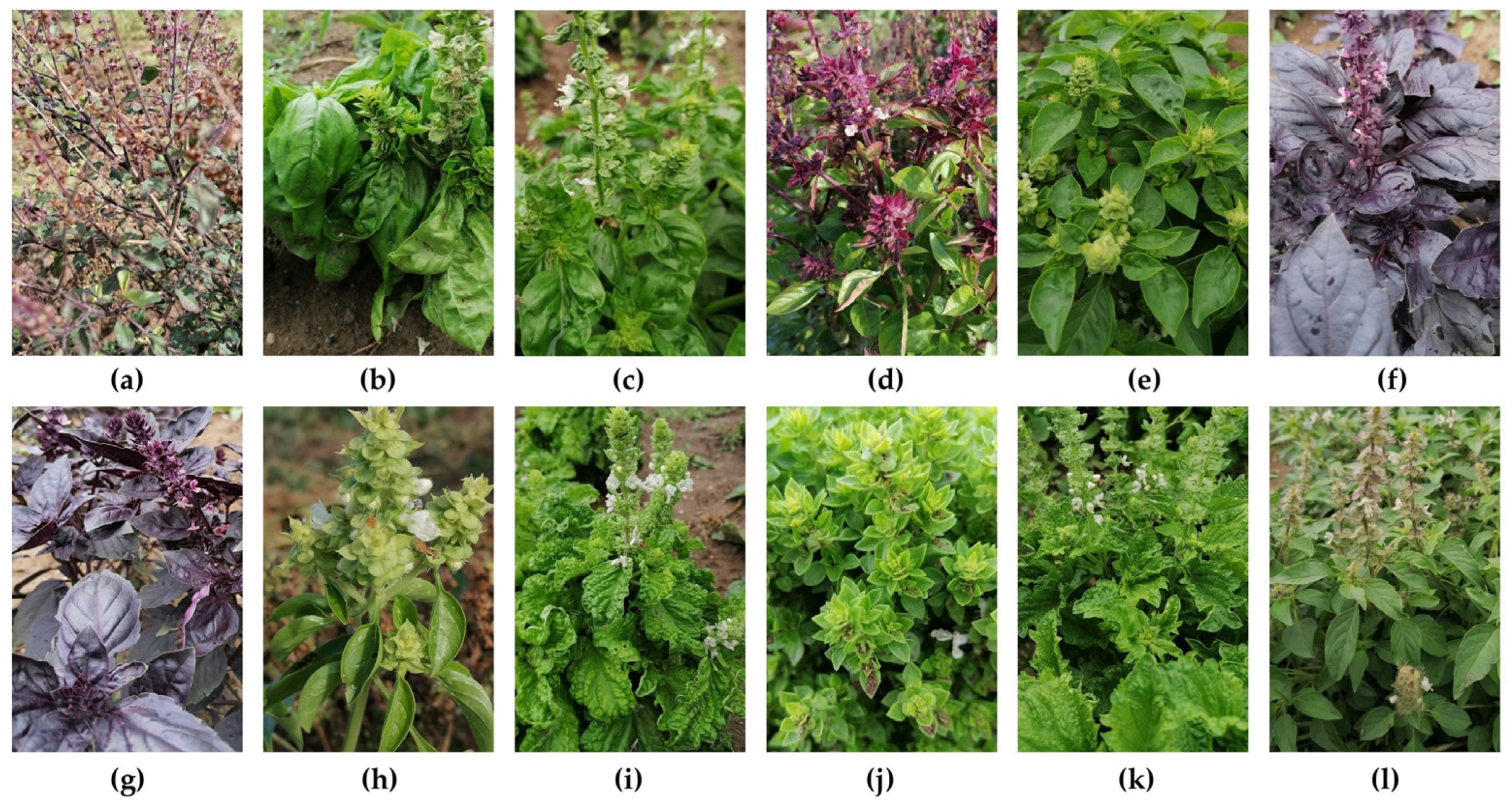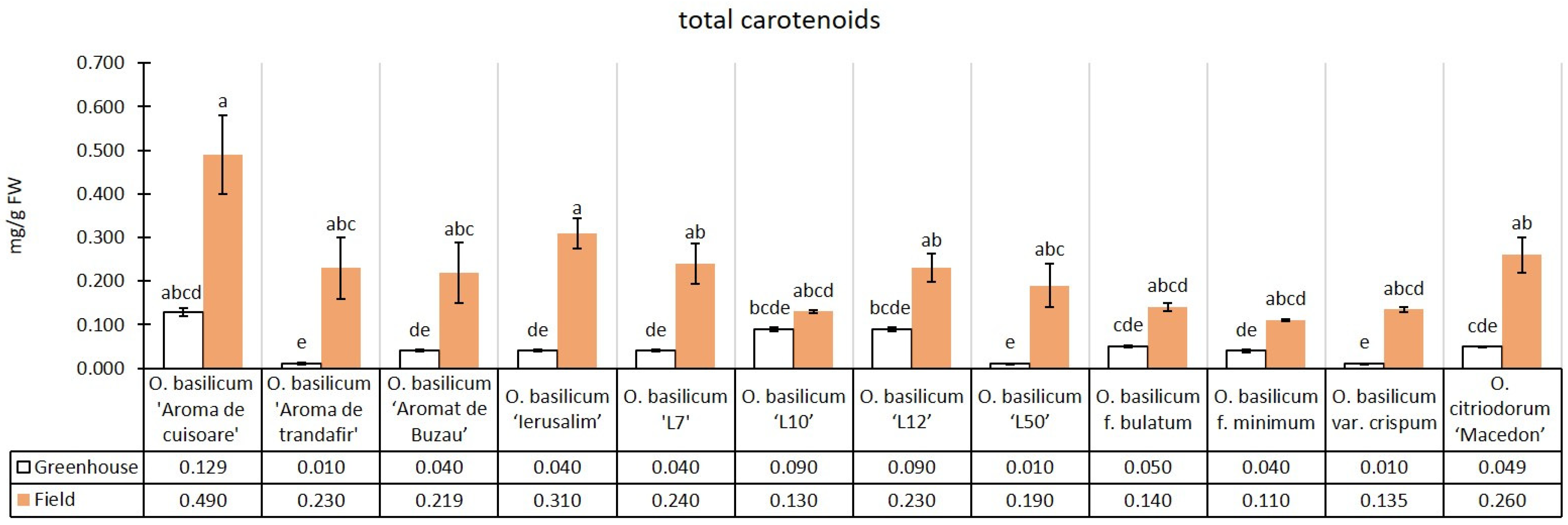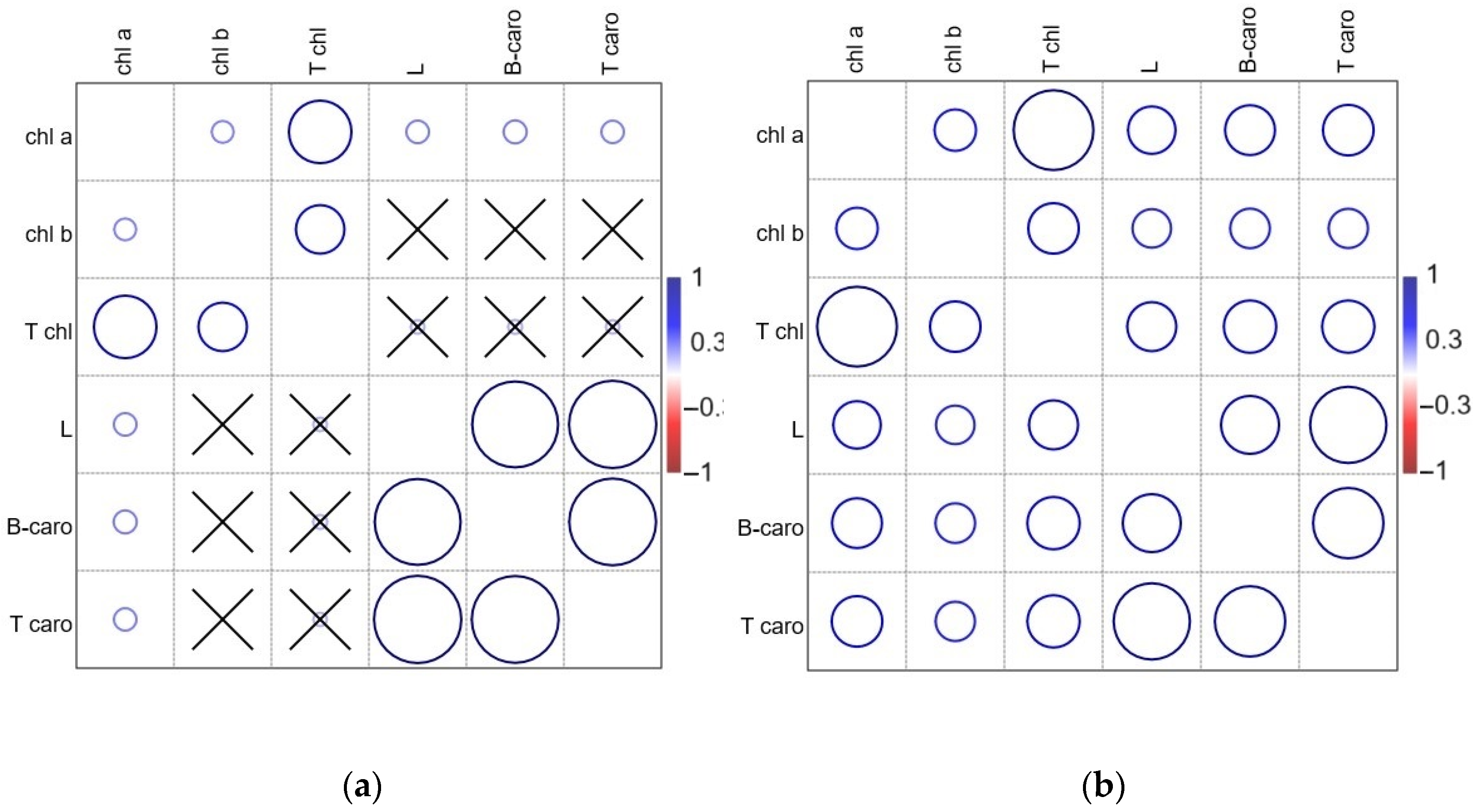Variation in the Photosynthetic Leaf Pigments of Different Basil (Ocimum spp.) Genotypes under Varying Conditions at the Flowering Stage
Abstract
1. Introduction
2. Materials and Methods
2.1. Biologic Material
2.2. Location and Conditions
2.3. Extraction of Chlorophyll
Chlorophyll b (mg/g) = (18.61 × A645 − 3.96 × A663) × V/g
2.4. Extraction of Carotenoids
2.5. Statistical Analysis of Leaf Pigments
3. Results
3.1. Chlorophylls
3.2. Carotenoids
3.3. Relationship between Photosynthetic Leaf Pigments
3.4. Principal Component Analysis of Photosynthetic Pigments
4. Discussion
5. Conclusions
Author Contributions
Funding
Data Availability Statement
Conflicts of Interest
References
- Stefanaki, A.; van Andel, T. Chapter 3—Mediterranean Aromatic Herbs and Their Culinary Use. In Aromatic Herbs in Food; Galanakis, C.M., Ed.; Academic Press: Cambridge, MA, USA, 2021; pp. 93–121. ISBN 978-0-12-822716-9. [Google Scholar]
- Codex Alimentarius Commission 2017. Available online: https://www.fao.org/fao-who-codexalimentarius/sh-proxy/tr/?lnk=1&url=https%253A%252F%252Fworkspace.fao.org%252Fsites%252Fcodex%252FMeetings%252FCX-736-03%252Fsc03_CRD16x.pdf (accessed on 12 May 2024).
- Spence, C. Sweet Basil: An Increasingly Popular Culinary Herb. Int. J. Gastron. Food Sci. 2024, 36, 100927. [Google Scholar] [CrossRef]
- Ervina, E.; Bryant, K.; Dwi, L.N.F.; Wahyudi, D. Sensory Characteristics and Consumer Liking of Basil Syrups (Ocimum basilicum L.) in Different Sensory Settings. Pol. J. Food Nutr. Sci. 2023, 73, 233–241. [Google Scholar] [CrossRef]
- Abidoye, A.O.; Ojedokun, F.O.; Fasogbon, B.M.; Bamidele, O.P. Effects of Sweet Basil Leaves (Ocimum Basilicum L) Addition on the Chemical, Antioxidant, and Storage Stability of Roselle Calyces (Hibiscus Sabdariffa) Drink. Food Chem. 2022, 371, 131170. [Google Scholar] [CrossRef] [PubMed]
- Haas, R.A.; Crișan, I.; Vârban, D.; Stoie, A.; Vârban, R. Melliferous Aromatic Plants. Hop. Med. Plants 2023, 31, 67–81. [Google Scholar]
- Bączek, K.; Kosakowska, O.; Gniewosz, M.; Gientka, I.; Węglarz, Z. Sweet Basil (Ocimum basilicum L.) Productivity and Raw Material Quality from Organic Cultivation. Agronomy 2019, 9, 279. [Google Scholar] [CrossRef]
- Majkowska-Gadomska, J.; Kulczycka, A.; Dobrowolski, A.; Mikulewicz, E. Yield and Nutritional Value of Basil Grown in a Greenhouse. Acta Agroph. 2017, 24, 455–464. [Google Scholar]
- Teliban, G.-C.; Popa, L.D.; Buducea, M.; Precupeanu, C.; Stan, T.; Agapie, A.; Naie, M.; Dumitru, I.; Stoleru, V. Research on the Obtaining Basil in Pots, in Greenhouse Conditions. In Proceedings of the ISB-INMA THE’ 2021 Agricultural and Mechanical Engineering, Bucharest, Romania, 29 October 2021. [Google Scholar]
- Meier, U. Growth Stages of Mono- and Dicotyledonous Plants: BBCH Monograph. 2018. Available online: https://www.openagrar.de/receive/openagrar_mods_00042351 (accessed on 12 May 2024).
- UPOV Guidelines for the Conduct of Tests for Distinctness, Uniformity and Stability Ocimum basilicum L. 2016. Available online: https://www.upov.int/edocs/tgdocs/en/tg200.pdf (accessed on 12 May 2024).
- Ćavar Zeljković, S.; Komzáková, K.; Šišková, J.; Karalija, E.; Smékalová, K.; Tarkowski, P. Phytochemical Variability of Selected Basil Genotypes. Ind. Crops Prod. 2020, 157, 112910. [Google Scholar] [CrossRef]
- Yaldiz, G.; Camlica, M. Essential Oils Content, Composition and Antioxidant Activity of Selected Basil (Ocimum basilicum L.) Genotypes. S. Afr. J. Bot. 2022, 151, 675–694. [Google Scholar] [CrossRef]
- Sharma, R.; Bhatia, S.; Kaur, P. Influence of Packaging and Storage Conditions on Biochemical Quality and Enzymatic Activity in Relation to Shelf Life Enhancement of Fresh Basil Leaf. J. Food Sci. Technol. 2018, 55, 3199–3211. [Google Scholar] [CrossRef]
- Chaves, R.P.F.; de Araújo, A.L.; Lopes, A.S.; Pena, R.d.S. Convective Drying of Purple Basil (Ocimum basilicum L.) Leaves and Stability of Chlorophyll and Phenolic Compounds during the Process. Plants 2023, 12, 127. [Google Scholar] [CrossRef]
- Index Seminum Hortus Agro-Botanicus Napocensis; AcademicPres: Cluj-Napoca, Romania, 2023; ISSN 1223-6055.
- Vînătoru, C.; Mușat Zamfir, B.; Bratu, C.; Peticila, A. Results and Perspectives in Ocimum Basilicum (Basil) Breeding at Vegetable Research and Development Station Buzău. Sci. Pap. Ser. B Hortic. 2019, 58, 161–168. [Google Scholar]
- Climate Data of 2022, Cluj-Napoca, Romania. Available online: https://en.tutiempo.net/climate/romania.html (accessed on 9 July 2024).
- Srivastava, R.K.; Kumar, S.; Sharma, R.S. Ocimum as a Promising Commercial Crop. In The Ocimum Genome; Shasany, A.K., Kole, C., Eds.; Springer International Publishing: Cham, Switzerland, 2018; pp. 1–7. ISBN 978-3-319-97430-9. [Google Scholar]
- Vârban, D.; Zăhan, M.; Pop, C.R.; Socaci, S.; Ștefan, R.; Crișan, I.; Bota, L.E.; Miclea, I.; Muscă, A.S.; Deac, A.M.; et al. Physicochemical Characterization and Prospecting Biological Activity of Some Authentic Transylvanian Essential Oils: Lavender, Sage and Basil. Metabolites 2022, 12, 962. [Google Scholar] [CrossRef]
- Clapa, D.; Bunea, C.; Borsai, O.; Pintea, A.; Hârța, M.; Ştefan, R.; Fira, A. The Role of Sequestrene 138 in Highbush Blueberry (Vaccinium corymbosum L.) Micropropagation. HortScience 2018, 53, 1487–1493. [Google Scholar] [CrossRef]
- Bunea, C.-I.; Pop, N.; Babeş, A.C.; Matea, C.; Dulf, F.V.; Bunea, A. Carotenoids, Total Polyphenols and Antioxidant Activity of Grapes (Vitis vinifera) Cultivated in Organic and Conventional Systems. Chem. Cent. J. 2012, 6, 66. [Google Scholar] [CrossRef] [PubMed]
- Simkin, A.J.; Kapoor, L.; Doss, C.G.P.; Hofmann, T.A.; Lawson, T.; Ramamoorthy, S. The Role of Photosynthesis Related Pigments in Light Harvesting, Photoprotection and Enhancement of Photosynthetic Yield in Planta. Photosynth. Res. 2022, 152, 23–42. [Google Scholar] [CrossRef]
- Gossa, A.G.; Asfaw, B.T. Diversity of Ethiopian Sweet Basil (Ocimum basilicum L.) Germplasm for Quantitative Morphological Traits. Flora 2023, 304, 152313. [Google Scholar] [CrossRef]
- Teodorescu, E.; Berevoianu, R.L.; Burnichi, F.; Petre, C. Phenotypic Evaluation and Economic Efficiency Concerning a Basil Germplasm Collection from S-E Romania. In Proceedings of the XXX International Horticultural Congress IHC2018: International Symposium on Medicinal and Aromatic Plants, Culinary Herbs and Edible Fungi, IV International Jujube Symposium and VI International Symposium on Saffron Biology and Technology, Istanbul, Turkey, 12–16 August 2018; pp. 135–144. [Google Scholar] [CrossRef]
- Kopsell, D.A.; Kopsell, D.E.; Curran-Celentano, J. Carotenoid and Chlorophyll Pigments in Sweet Basil Grown in the Field and Greenhouse. HortScience 2005, 40, 1230–1233. [Google Scholar] [CrossRef]
- Proz, M.d.l.Á.; da Silva, M.A.S.; Rodrigues, E.; Bender, R.J.; Rios, A. de O. Effects of Indoor, Greenhouse, and Field Cultivation on Bioactive Compounds from Parsley and Basil. J. Sci. Food Agric. 2021, 101, 6320–6330. [Google Scholar] [CrossRef]
- Stetsenko, L.A.; Pashkovsky, P.P.; Voloshin, R.A.; Kreslavski, V.D.; Kuznetsov, V.V.; Allakhverdiev, S.I. Role of Anthocyanin and Carotenoids in the Adaptation of the Photosynthetic Apparatus of Purple- and Green-Leaved Cultivars of Sweet Basil (Ocimum basilicum) to High-Intensity Light. Photosynthetica 2020, 58, 890–901. [Google Scholar] [CrossRef]
- Fayezizadeh, M.R.; Ansari, N.A.; Sourestani, M.M.; Hasanuzzaman, M. Biochemical Compounds, Antioxidant Capacity, Leaf Color Profile and Yield of Basil (Ocimum sp.) Microgreens in Floating System. Plants 2023, 12, 2652. [Google Scholar] [CrossRef]
- Tanaka, R.; Tanaka, A. Chlorophyll Cycle Regulates the Construction and Destruction of the Light-Harvesting Complexes. Biochim. Biophys. Acta BBA Bioenerg. 2011, 1807, 968–976. [Google Scholar] [CrossRef] [PubMed]
- Björn, L.O.; Papageorgiou, G.C.; Blankenship, R.E. Govindjee A Viewpoint: Why Chlorophyll a? Photosynth. Res. 2009, 99, 85–98. [Google Scholar] [CrossRef] [PubMed]
- Voitsekhovskaja, O.V.; Tyutereva, E.V. Chlorophyll b in Angiosperms: Functions in Photosynthesis, Signaling and Ontogenetic Regulation. J. Plant Physiol. 2015, 189, 51–64. [Google Scholar] [CrossRef]
- Crișan, I.; Balestrini, R.; Pagliarani, C. The Current View on Heavy Metal Remediation: The Relevance of the Plant Interaction with Arbuscular Mycorrhizal Fungi. Plant Stress 2024, 12, 100439. [Google Scholar] [CrossRef]
- Quian-Ulloa, R.; Stange, C. Carotenoid Biosynthesis and Plastid Development in Plants: The Role of Light. Int. J. Mol. Sci. 2021, 22, 1184. [Google Scholar] [CrossRef]
- Maslova, T.G.; Markovskaya, E.F.; Slemnev, N.N. Functions of Carotenoids in Leaves of Higher Plants (Review). Biol. Bull. Rev. 2021, 11, 476–487. [Google Scholar] [CrossRef]
- Dhami, N.; Cazzonelli, C.I. Environmental Impacts on Carotenoid Metabolism in Leaves. Plant Growth Regul. 2020, 92, 455–477. [Google Scholar] [CrossRef]
- Sun, T.; Rao, S.; Zhou, X.; Li, L. Plant Carotenoids: Recent Advances and Future Perspectives. Mol. Hortic. 2022, 2, 3. [Google Scholar] [CrossRef]
- Grainger, E.M.; Webb, M.Z.; Simpson, C.M.; Chitchumroonchokchai, C.; Riedl, K.; Moran, N.E.; Clinton, S.K. Chapter Eight—Assessment of Dietary Carotenoid Intake and Biologic Measurement of Exposure in Humans. In Methods in Enzymology; Wurtzel, E.T., Ed.; Carotenoids: Biological Functions of Carotenoids and Apocarotenoids in Natural and Artificial Systems; Academic Press: Cambridge, MA, USA, 2022; Volume 674, pp. 255–295. [Google Scholar]
- Ningsih, Y.W.; Devi, M.; Kiranawati, T.M. The Effect of Basil Leaves (Ocimum basilicum) Addition to Contents of β-Carotene, Calcium Levels, and Hedonic Test of Basil Leaves Biscuits; Atlantis Press: Amsterdam, The Netherlands, 2020; pp. 248–254. [Google Scholar]
- Ciriello, M.; Fusco, G.M.; Colla, G.; Kyriacou, M.C.; Sabatino, L.; De Pascale, S.; Rouphael, Y.; Carillo, P. Adaptation of Basil to Salt Stress: Molecular Mechanism and Physiological Regulation. Plant Stress 2024, 11, 100431. [Google Scholar] [CrossRef]
- Copolovici, L.; Lupitu, A.; Moisa, C.; Taschina, M.; Copolovici, D.M. The Effect of Antagonist Abiotic Stress on Bioactive Compounds from Basil (Ocimum basilicum). Appl. Sci. 2021, 11, 9282. [Google Scholar] [CrossRef]
- Khater, E.-S.; Bahnasawy, A.; Abass, W.; Morsy, O.; El-Ghobashy, H.; Shaban, Y.; Egela, M. Production of Basil (Ocimum basilicum L.) under Different Soilless Cultures. Sci. Rep. 2021, 11, 12754. [Google Scholar] [CrossRef] [PubMed]









| Genotype | Common Name | Herbarium CLA | IPEN Code | Experimental Variants | |
|---|---|---|---|---|---|
| Greenhouse BBCH 65 | Field BBCH 65 | ||||
| O. basilicum ‘Aromă de cuișoare’ (cloves aroma) | sweet basil | 30327 | XX-0-CLA-5034 | V1 | V13 |
| O. basilicum ‘Aromă de trandafir’ (rose aroma) | sweet basil | 30328 | XX-0-CLA-5035 | V2 | V14 |
| O. basilicum ‘Aromat de Buzău’ | sweet basil | 30329 | XX-0-CLA-5036 | V3 | V15 |
| O. basilicum ‘Ierusalim’ | sweet basil | 30330 | XX-0-CLA-5037 | V4 | V16 |
| O. basilicum ‘L7’ (green leaf) | sweet basil | 30331 | XX-0-CLA-5038 | V5 | V17 |
| O. basilicum ‘L10’ (purple leaf) | sweet basil | 30332 | XX-0-CLA-5039 | V6 | V18 |
| O. basilicum ‘L12’ (purple leaf) | sweet basil | 30333 | XX-0-CLA-5040 | V7 | V19 |
| O. basilicum ‘L50’ (green leaf) | sweet basil | 30334 | XX-0-CLA-5041 | V8 | V20 |
| O. basilicum f. bulatum | blistered leaf basil | 30335 | XX-0-CLA-5042 | V9 | V21 |
| O. basilicum f. minimum | bush basil | 30336 | XX-0-CLA-5043 | V10 | V22 |
| O. basilicum var. crispum | lettuce leaf basil | 30337 | XX-0-CLA-5044 | V11 | V23 |
| O. citriodorum ‘Macedon’ (lemon aroma) | lemon basil | 30338 | XX-0-CLA-5045 | V12 | V24 |
| Parameter | Chlorophyll a | Chlorophyll b | Total Chlorophyll | Lutein | β-Carotene | Total Carotenoids |
|---|---|---|---|---|---|---|
| χ2 | 54.22 | 58.47 | 54.69 | 69.35 | 65.88 | 67.98 |
| p-value | <0.001 | <0.001 | <0.001 | <0.001 | <0.001 | <0.001 |
Disclaimer/Publisher’s Note: The statements, opinions and data contained in all publications are solely those of the individual author(s) and contributor(s) and not of MDPI and/or the editor(s). MDPI and/or the editor(s) disclaim responsibility for any injury to people or property resulting from any ideas, methods, instructions or products referred to in the content. |
© 2024 by the authors. Licensee MDPI, Basel, Switzerland. This article is an open access article distributed under the terms and conditions of the Creative Commons Attribution (CC BY) license (https://creativecommons.org/licenses/by/4.0/).
Share and Cite
Crișan, I.; Bunea, A.; Vârban, D.; Cordea, M.I.; Horga, V.; Vînătoru, C.; Stoie, A.; Vârban, R. Variation in the Photosynthetic Leaf Pigments of Different Basil (Ocimum spp.) Genotypes under Varying Conditions at the Flowering Stage. Horticulturae 2024, 10, 740. https://doi.org/10.3390/horticulturae10070740
Crișan I, Bunea A, Vârban D, Cordea MI, Horga V, Vînătoru C, Stoie A, Vârban R. Variation in the Photosynthetic Leaf Pigments of Different Basil (Ocimum spp.) Genotypes under Varying Conditions at the Flowering Stage. Horticulturae. 2024; 10(7):740. https://doi.org/10.3390/horticulturae10070740
Chicago/Turabian StyleCrișan, Ioana, Andrea Bunea, Dan Vârban, Mirela Irina Cordea, Vasile Horga, Costel Vînătoru, Andrei Stoie, and Rodica Vârban. 2024. "Variation in the Photosynthetic Leaf Pigments of Different Basil (Ocimum spp.) Genotypes under Varying Conditions at the Flowering Stage" Horticulturae 10, no. 7: 740. https://doi.org/10.3390/horticulturae10070740
APA StyleCrișan, I., Bunea, A., Vârban, D., Cordea, M. I., Horga, V., Vînătoru, C., Stoie, A., & Vârban, R. (2024). Variation in the Photosynthetic Leaf Pigments of Different Basil (Ocimum spp.) Genotypes under Varying Conditions at the Flowering Stage. Horticulturae, 10(7), 740. https://doi.org/10.3390/horticulturae10070740






